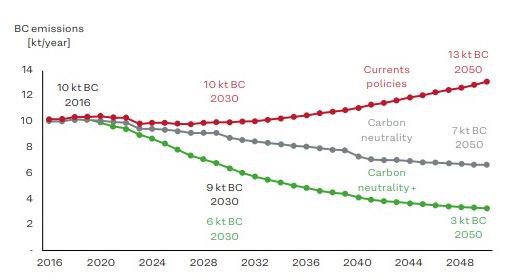This is a feature by the Climate and Clean Air Coalition.
Chile is particularly vulnerable to climate change and is already experiencing climate change impacts, including a long-standing drought in central and southern Chile, which began in 2010. These impacts are projected to increase in the future, impacting agricultural productivity, forest fires, indigenous communities and biodiversity.
Chile’s President, Sebastian Piñera, acknowledge that substantially more ambitious action is needed globally to reduce greenhouse gases and avoid catastrophic climate change, saying:
“Even by fulfilling all the commitments of the Paris Agreement now, the temperature would significantly exceed the target established, reaching an increase of almost 3.4 degrees, which is disastrous. We need much more demanding and ambitious commitments and measures to limit temperature rise to 1.5 degrees at most.”
In April 2020, recognising the need for all countries to take drastic action to mitigate climate change, Chile submitted their revised Nationally Determined Contribution (NDC), which outlines their updated commitment to mitigating climate change. Chile’s commitment involves greenhouse gas (GHG) emissions peaking by 2025 at the latest, and then a decrease to emit no more than 95 million tonnes of greenhouse gases by 2030. These medium-term emission pledges are made in the context of a long-term vision and goal of GHG neutrality by 2050.
“We need much more demanding and ambitious commitments and measures to limit temperature rise to 1.5 degrees at most.”
Sebastian Piñera, President of Chile
Chile also makes a further commitment in their revised NDC, to reduce black carbon emissions by 25% in 2030 compared to 2016 levels. Black carbon is a ‘short-lived climate pollutant’ (SLCP), so-called because it has a short atmospheric lifetime (a few days to a week), and because it directly contributes to atmospheric warming (through absorption of incoming radiation and through deposition on snow and ice). It is also a dangerous air pollutant.
As a component of fine particulate matter, or PM2.5, black carbon is also a dangerous air pollutant. According to the World Health Organization PM2.5 is responsible for an estimated 7 million premature deaths per year, including five thousand in Chile in 2017. The major sources of black carbon in Chile are diesel vehicles, off-road machinery, firewood for heating and residential cooking, and biomass used as an energy source in the industrial sector. These sectors also emit other air pollutants, like nitrogen oxides, volatile organic compounds, other particulates, and in some cases greenhouse gases like carbon dioxide. Reducing emissions from major black carbon sources is therefore an effective strategy to simultaneously mitigate climate change while achieving local air quality and health benefits.
“Boosting Chile’s climate change commitment, including a target to reduce black carbon highlights the importance of linking local policies with international policies,” said Jenny Mager, Head of mitigation and inventories, Climate Change Office, at Chile’s Ministry of Environment. “Achieving this black carbon target will improve air quality and human health. It will require various actions, including atmospheric decontamination plans, transport regulations, improvement in household energy efficiency; and emission standards for the main industrial polluters.”
A comprehensive analysis was conducted to assess Chile’s potential to reduce black carbon across all sources. It showed that, in 2030, with no new policies implemented, black carbon levels would remain at 2016 levels, and then increase by 30% by 2050. However, a ‘carbon neutrality’ scenario will substantially reduce black carbon emissions, 13% in 2030, and 35% in 2050 compared to 2016 levels. This emphasises the important additional benefits that decarbonisation has for improved air quality. A second scenario ‘carbon neutrality +’, included additional actions that specifically targeted black carbon sources, which would reduce black carbon emissions even further, up to 75% in 2050, compared to 2016 levels (see Figure 1 below).

“These two scenarios were developed taking into account national and international public policy documents. The ‘carbon neutrality + scenarios’ shows the increased benefits of taking action in key black carbon sectors, like district heating in the residential sector, and reducing emissions in the off-road machinery, and industrial sectors,” said Kevin Basoa from the Universidad Tecnológica Metropolitana in Santiago, Chile.
Professor Laura Gallardo, University of Chile, and who led the black carbon work in Chile’s NDC revision said: “Taking actions to reduce black carbon provides a sustainable way to bring clean air to Chile’s cities, while simultaneously addressing two of Chile’s most pressing problems, energy poverty and environmental inequality.’
To achieve Chile’s GHG and black carbon emission reduction targets, a wide range of policies and measures need to be implemented (see Figure 2 below).
‘We conducted an economic assessment of relevant policies and measures as part of the NDC revision process,” Jenny Mager, said. ‘It showed that many of the actions that can simultaneously reduce black carbon and GHGs were also among the most cost effective’.
Examples of such actions include electric heating in the residential sector and switching to cleaner fuels (electricity and hydrogen) in the transport sector.
“The updated climate change commitment submitted by Chile is an important milestone as it recognises the additional value of taking action on black carbon alongside ambitious goals to reduce both short-lived and long-lived greenhouse gases and achieving carbon neutrality,” Helena Molin Valdés, Head of the Climate and Clean Air Coalition Secretariat said. “This message has been at the heart of the Climate and Clean Air Coalition since its foundation. We look forward to working with Chile to make their ambition a reality, and encourage all countries revising their NDCs to consider actions that can both maximise local benefits for air quality and provides the ambitious action needed to achieve the Paris Agreement’s goals.”
Chile has been a partner in the Climate and Clean Air Coalition since 2012 and participates in the Coalition’s National Planning Initiative (SNAP), which provides methodologies and technical support on SLCPs and integrated air pollution and climate change planning. The support provided is tailored to each country, ranging from initial assessments of major emission sources and the development of National Action Plans, to integration of SLCPs within climate change planning processes.
